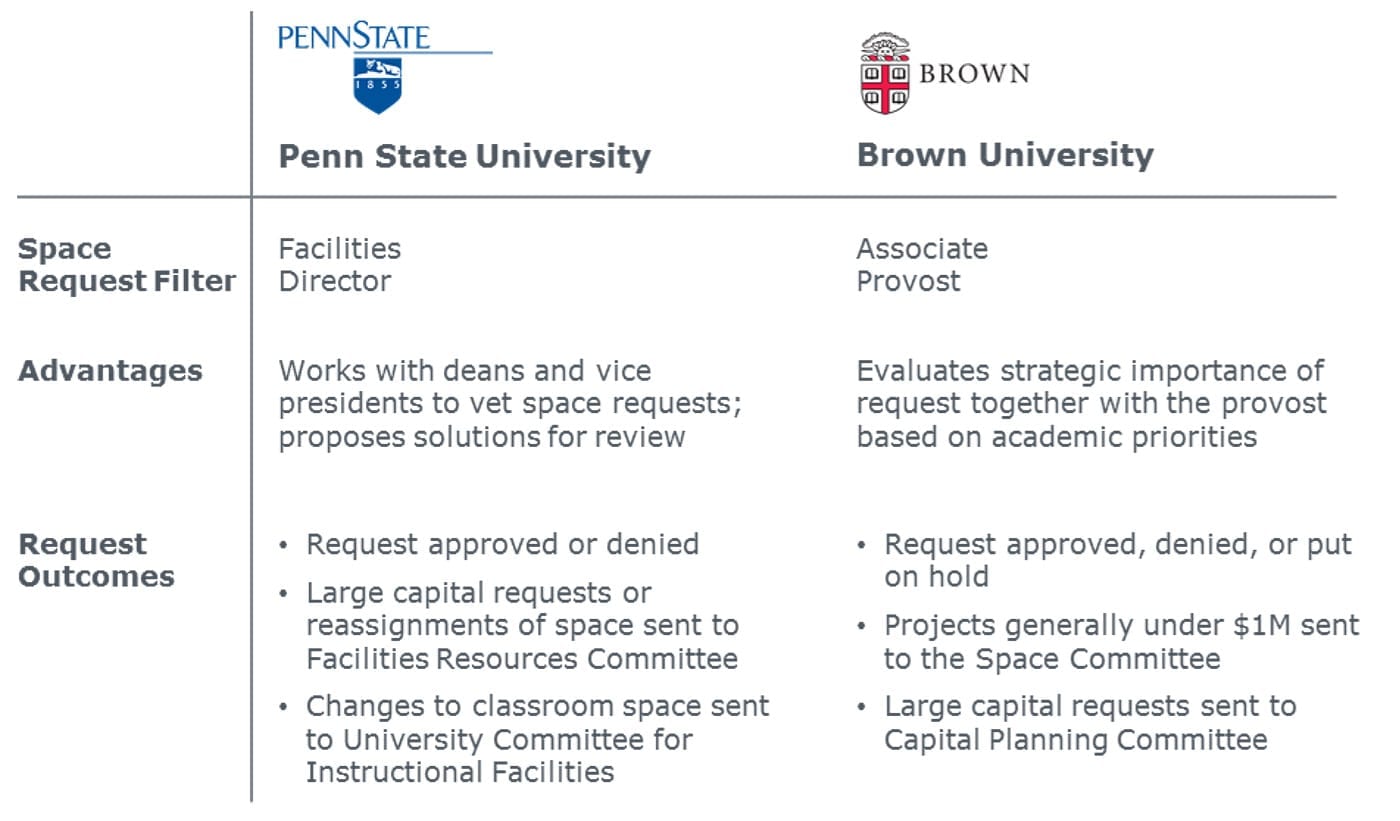Space committees can be an important decision-making body on university campuses, helping to generate consensus among senior leaders and shape space management policies. However, they often fail to drive better space decision making, typically because institutions struggle to pinpoint the right membership and ensure the right conversations take place.
Space committees are most likely to stall when the institution fails to properly scope the issues in the committee’s purview. While many institutions are most concerned with selecting the right membership for their space committee, assembling the right group is important but not sufficient to guarantee a committee’s success. Institutions must also ensure that the requests the committee reviews are relevant to members.
Institutions can keep space committees on track by creating a tiered review process to vet requests and send the most important ones to a senior space committee for review. Facilities Forum research has revealed three successful space committee models.
Option #1: The gatekeeper model
The first option for creating a tiered space request resolution process is to appoint a single person, or gatekeeper, to review all space requests before they go to the space committee. The gatekeeper vets each request, approving small projects and sending certain requests to the space committee for further review. Pennsylvania State University and Brown University each utilize the gatekeeper model, each using a different person to fill the role.

 At Penn State, the Facilities Director serves as the gatekeeper, vetting the viability and cost of every space request. Meanwhile, Brown uses an Associate Provost to screen space requests against academic priorities. In both models, the space committee only receives requests that pass the gatekeeper’s screening process. This protects the committee’s time and ensures senior-level members focus on the most important space decisions.
At Penn State, the Facilities Director serves as the gatekeeper, vetting the viability and cost of every space request. Meanwhile, Brown uses an Associate Provost to screen space requests against academic priorities. In both models, the space committee only receives requests that pass the gatekeeper’s screening process. This protects the committee’s time and ensures senior-level members focus on the most important space decisions.
How to involve academic leaders in the space utilization process
Two Facilities Committee Models
Option #2: Bicameral space committee
The second option for establishing a tiered space request resolution process is to establish a bicameral space committee. In this model, a junior space committee reviews all space requests, approving routine requests and small projects, and only sends the most important decisions to the senior committee.
At Boston University, the more junior sub-SPACE (Space Planning and Capital Expenditures) committee is an eight-person group composed of a mix of Facilities employees and assistant vice presidents. It meets bi-weekly, independently considering and deciding on projects under $1 million. For more expensive or complex projects, they augment the request with cost estimates and alternative solutions before sending it on to the senior SPACE committee, composed of the president and five vice and senior vice presidents, for review.
Because of the junior committee’s scoping work, the senior SPACE committee is able to meet less frequently and resolve issues faster. While the bicameral model requires more people than the gatekeeper option, the junior committee is able to assume more administrative responsibilities from the senior committee, further protecting the time of senior leaders.
Option #3: Email-only renovation committee
The final option for establishing a tiered space request resolution process is establishing an email-only committee. In this model, committee members review, discuss, and vote on requests via email, decreasing the time commitment by building in flexibility. For example, Florida International University uses an email-only space committee to review all incoming space requests, ranging from temporary art installations to major space renovations. Once the office of space management reviews a space request to ensure it is appropriately scoped and make a recommendation, it is sent via email to the entire committee. Members all review it by an agreed upon deadline or appoint a proxy to review it in their absence. Final votes are submitted via email, and the project is either approved or denied.
Beyond the efficiency of the email-only committee, Florida International has found that requiring faculty, departments, and colleges to seek approval for all campus space changes made to any campus space has led to a decreased sense of ownership over space. Instead, faculty and staff are beginning to view it more as a central resource.
Importantly, Florida International’s email-only committee was a natural evolution of a highly successful, well-established in-person committee. Institutions should only consider pursing this third option after they have had a trusted space request evaluation process in place for a year or more.
Solidifying the space request process
No matter which committee structure you use, clarifying the decision-making process is crucial for success. When people don’t understand how the process works, they are more likely to use informal channels and circumvent the space committee.
University of Maryland, Baltimore County (UMBC) has created an outline of their space request decision-making process. By clearly laying out the path of a space request from the initial request to approval, UMBC ensures that everyone on campus understands how space decisions are made. You can view UMBC’s flowchart here.
What’s the next step in improving space governance?
Space committees are just one way you can improve your institution’s space management process. Download our study,Working with Academic Leaders to Improve Space Utilziation, to discover best practices you can utilize to inflect behavior change and improve utilization rates.